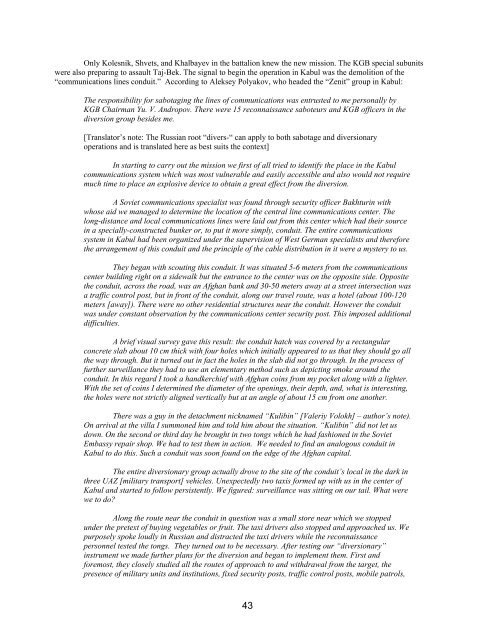Aleksandr Antonovich Lyakhovskiy Working Paper pp - Woodrow ...
Aleksandr Antonovich Lyakhovskiy Working Paper pp - Woodrow ...
Aleksandr Antonovich Lyakhovskiy Working Paper pp - Woodrow ...
Create successful ePaper yourself
Turn your PDF publications into a flip-book with our unique Google optimized e-Paper software.
Only Kolesnik, Shvets, and Khalbayev in the battalion knew the new mission. The KGB special subunits<br />
were also preparing to assault Taj-Bek. The signal to begin the operation in Kabul was the demolition of the<br />
“communications lines conduit.” According to Aleksey Polyakov, who headed the “Zenit” group in Kabul:<br />
The responsibility for sabotaging the lines of communications was entrusted to me personally by<br />
KGB Chairman Yu. V. Andropov. There were 15 reconnaissance saboteurs and KGB officers in the<br />
diversion group besides me.<br />
[Translator’s note: The Russian root “divers-“ can a<strong>pp</strong>ly to both sabotage and diversionary<br />
operations and is translated here as best suits the context]<br />
In starting to carry out the mission we first of all tried to identify the place in the Kabul<br />
communications system which was most vulnerable and easily accessible and also would not require<br />
much time to place an explosive device to obtain a great effect from the diversion.<br />
A Soviet communications specialist was found through security officer Bakhturin with<br />
whose aid we managed to determine the location of the central line communications center. The<br />
long-distance and local communications lines were laid out from this center which had their source<br />
in a specially-constructed bunker or, to put it more simply, conduit. The entire communications<br />
system in Kabul had been organized under the supervision of West German specialists and therefore<br />
the arrangement of this conduit and the principle of the cable distribution in it were a mystery to us.<br />
They began with scouting this conduit. It was situated 5-6 meters from the communications<br />
center building right on a sidewalk but the entrance to the center was on the o<strong>pp</strong>osite side. O<strong>pp</strong>osite<br />
the conduit, across the road, was an Afghan bank and 30-50 meters away at a street intersection was<br />
a traffic control post, but in front of the conduit, along our travel route, was a hotel (about 100-120<br />
meters [away]). There were no other residential structures near the conduit. However the conduit<br />
was under constant observation by the communications center security post. This imposed additional<br />
difficulties.<br />
A brief visual survey gave this result: the conduit hatch was covered by a rectangular<br />
concrete slab about 10 cm thick with four holes which initially a<strong>pp</strong>eared to us that they should go all<br />
the way through. But it turned out in fact the holes in the slab did not go through. In the process of<br />
further surveillance they had to use an elementary method such as depicting smoke around the<br />
conduit. In this regard I took a handkerchief with Afghan coins from my pocket along with a lighter.<br />
With the set of coins I determined the diameter of the openings, their depth, and, what is interesting,<br />
the holes were not strictly aligned vertically but at an angle of about 15 cm from one another.<br />
There was a guy in the detachment nicknamed “Kulibin” [Valeriy Volokh] – author’s note).<br />
On arrival at the villa I summoned him and told him about the situation. “Kulibin” did not let us<br />
down. On the second or third day he brought in two tongs which he had fashioned in the Soviet<br />
Embassy repair shop. We had to test them in action. We needed to find an analogous conduit in<br />
Kabul to do this. Such a conduit was soon found on the edge of the Afghan capital.<br />
The entire diversionary group actually drove to the site of the conduit’s local in the dark in<br />
three UAZ [military transport] vehicles. Unexpectedly two taxis formed up with us in the center of<br />
Kabul and started to follow persistently. We figured: surveillance was sitting on our tail. What were<br />
we to do<br />
Along the route near the conduit in question was a small store near which we sto<strong>pp</strong>ed<br />
under the pretext of buying vegetables or fruit. The taxi drivers also sto<strong>pp</strong>ed and a<strong>pp</strong>roached us. We<br />
purposely spoke loudly in Russian and distracted the taxi drivers while the reconnaissance<br />
personnel tested the tongs. They turned out to be necessary. After testing our “diversionary”<br />
instrument we made further plans for the diversion and began to implement them. First and<br />
foremost, they closely studied all the routes of a<strong>pp</strong>roach to and withdrawal from the target, the<br />
presence of military units and institutions, fixed security posts, traffic control posts, mobile patrols,<br />
43

















